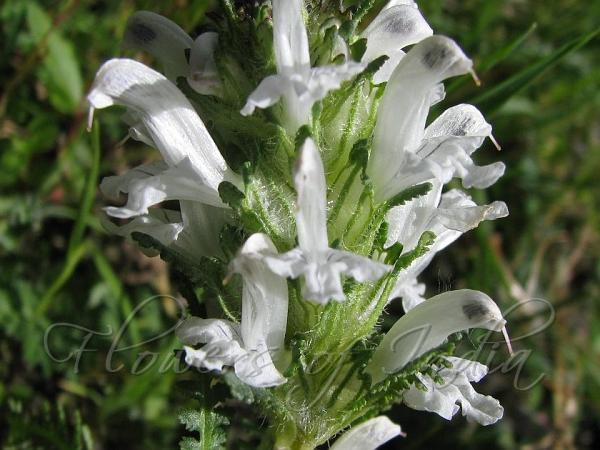|
| White Lousewort |
|

|

| File size | 107734 |
| Original date | 9/18/11 1:56 PM |
| Resolution | 840 x 630 |
| Flash | Flash did not fire, auto |
| Focal length | 6.0mm |
| Exposure time | 1/1600s |
| Aperture | 3.5 |
| Focus Distance | |
| Metering Mode | Center weighted average |
| Camera make | Canon |
| Camera model | Canon PowerShot S5 IS |
| Sensor type | OneChipColorArea |
|
|
|
|
Photo: |
Botanical name: Pedicularis albida Family: Orobanchaceae (Broomrape family)
Synonyms: Pedicularis cheilanthifolia var. albida
Synonyms: Pedicularis cheilanthifolia var. albida
White Lousewort is a perennial herb, 5-30 cm tall.
Flowers are white, stalkless, tube almost erect when young, becoming bent at a
right angle basally, up to 1.1-1.4 cm; galea falcate, about 1 cm, tip
with a short conical beak or beakless. Lower lip is 8-10 mm X 1-1.2 cm,
lobes rounded. Sepal cup is 8-9 mm, about 1/3 cleft
anteriorly, densely pilose along veins. Sepals are 5, unequal,
posterior one triangular, entire, lateral lobes larger, serrate.
Flowers are borne in a head or spike elongated to 10 cm.
Bracts are leaflike, about as long as flowers basally.
Stems are single and erect
or more than 10, unbranched, with 4 lines of hairs. Basal leaves are
carried on 3-4 cm long stalks. Stem leaves occur in whorls of 4, on
stalks 0.5-2 cm long. Leaves are linear-lanceshaped, 0.7-4 cm X 2.5-8
mm, pinnately cut into 8-12 pairs of segments, ovate-lanceolate to
linear-lanceolate, pinnatifid, double dentate or incised-dentate.
White Lousewort is found in central Asia and parts of
the Himalayas, at altitudes of 2100-5200 m. Flowering: June-August.
| Identification credit: Prashant Awale, Gurcharan Singh | Photographed in Ladakh. |
• Is this flower misidentified? If yes,